A while ago, I met Tad during a photo tour in Hoi An. Following this tour we have had an email discussion about 2 different ways of shooting people while traveling: getting close or staying far from your subject?
This discussion dates from a while back but I did lost track. Finally I am posting the summarized discussion that Tad shared on his blog.
Tad:
I’ve been thinking about photographing people. It seems to me that there are two ways to do it, and that both can produce good photos.
The method favoured by most professionals is to get up close. The advantages of this method include:
1) You can choose the background.
2) You have more control over the lighting, including fill-flash.
3) There is the choice of lower or higher viewpoint.
4) It is not sneaky and you get the co-operation of the person.
My approach is to use a 300mm lens, which on a 7D is equivalent to 480mm, and to shoot from a distance. The advantages of this method include:
1) You can take many more shots. It’s true that the vast majority are duds, but some are good.
2) You snap people unawares, capturing odd or funny faces and gestures, including fleeting expressions that last only a moment.
3) You don’t need to spend time on getting permission from each person, which may be refused, and does not suit less outgoing photographers.
4) People don’t freeze up because they usually don’t realise they are being photographed and do not have time to pose (or hide).
I think that both methods have their good points and drawbacks. Except for the sadhu, all the above photos from Nepal were unposed. I could not have gotten these unposed action shots by asking people whether I could photograph them.
Etienne Bossot is a professional photographer living in Hoi An, Vietnam. He and I have a very different approach to photographing people. My discussion with him is condensed below. Etienne commented:
In my opinion the best way is the one that suits you: if you love the contact with people then getting close will be more fun (we are not only shooting to get great shots, but it also is a hobby we like to practice), and if you are a bit shy then the long lens might be more suitable.
What I feel when looking at your photos (and of course it is only my opinion, from someone who likes to get close) is the detachment from your subject. They seem not aware they are being photographed, and I feel a lack of connection with them. For example, in Nepal 13 the man in the photo in the top right corner, I feel he is just walking, and he is not aware of you. But I do not know anything about him: who is he? Where is he going? In which environment is he?
Maybe getting closer to him would have taken more time and energy, and made him look different, but one could have taken the time to chat to him and include more elements in the photo (due to a wider angle lens) which would have helped tell a story about him.
You can also get close to people but without interacting with them. People who are busy working or doing some activity can be approached without noticing (at least for the first 10 seconds).
Some years ago I used to only shoot with a 50mm and getting very close. After a few years, I realized all my photos were very similar: getting close to someone with a 50mm only allowed me to get close-up portraits. And one close-up portrait is very similar to another close-up portrait. If you only use your 300mm lens you will end up with the same-looking portraits of different people. Getting close, and with a wide angle lens, allows you to include more foreground and background, which will show that you are in a different place, with a different light, working on a different subject.
Tad:
As Etienne says, there are many other ways of photographing people and it is a matter of personal preference. I agree that my photos show detachment from the people being portrayed. My images are the view of an interested and sympathetic observer, but one who does not interact with the subjects. Only a minority of my subjects realise I have taken their portrait, or they may only do so after the fact. I accept that my photos provide less context and less “story” than is the case with the up-close approach. I recently took some pleasing shots of kids playing using a 60mm. So I agree that it is good to be flexible with the choice of subject distance. I also agree that using the wide-angle lens gives you more chance to show where the person is and whom they are interacting with.
On the other hand, I capture glimpses of people that are not possible with the other method, such as the lady eating ice-cream and the laughing child. I also like the one showing three friends in an intimate way. If I asked them to pose I would never get that shot.
Etienne again:
My feeling, when looking at your photos using a long telephoto lens, is that you tend to have the same framing for all your photos. Basically your portraits start from the hip or higher and finish above the subject’s head. I used to always shoot the same portraits using a 50mm lens, this is the reason why I wanted to go wider with a 35mm, to allow me to be more creative with the surroundings and to get other angles. After all, a portrait is a portrait. Staying at the subject’s eye level helps make all portraits look similar.
Also, when shooting with a bulky long lens, people tend to shoot from where they are standing, offering the same angle on every photo. The shorter lens forces people to get closer and also helps them add foregrounds into their photos, meaning getting higher or getting low to shoot the subject, thus having more originality in the photos.
Getting close adds fun to photography, making contact with the people and learning about their culture. I think this is priceless from a personal point of view.
Tad again:
As regards framing, I reframe all my shots in Photoshop, some marginally, others drastically. Secondly, Etienne is right that I tend to frame people from the hips up or somewhat higher. I’ll think about varying my portraits more. However, I have done lots of head-only shots, such as these in Rome.
What I try to do is not to show the person in context but just to show them as a unique individual, standing out from whatever environment or group they are in. I hope to capture the individuality of each person. Maybe I am a soul-thief! To me, each person is already interesting, regardless of any background or foreground. Of course, I accept that a well-chosen background or foreground improves a portrait esthetically, as well as making it more interesting and meaningful. Yet that is not my way.
My preference is to photograph the head only, as this is the essence of a person. I like to catch an expression that reveals character or an emotional state. This is less likely to happen with a posed photo. Another difference between us is that Etienne would plan his shots. By contrast, I am a shameless opportunist, simply grabbing whatever comes along. No-one within 40 metres is safe!
Our discussion is restricted to photographing people, but when it comes to general photography, my real love is macro. So I do like to get up close, just not to people. One of the reasons I don’t like to shoot people from close-up is that I think a camera in the face is intimidating, whereas taking shots from three metres or more is less confronting. Of course, the least confronting method is to take photos that people are not even aware of. Some of my friends freeze up or get embarrassed if I photograph them. I too feel the camera’s presence more if someone is photographing me from very close.
Of course, Etienne may counter that the interaction between the subject and the photographer is at the heart of the process, and that a positive interaction can create an intimacy that will show in the resulting photographs. I have no argument with that.
Etienne:
I feel that shooting only with the framing you are mostly doing (from hips to head or even tighter) will make it much more difficult to get THE shot. I know I may be a little “too much” when talking about that but I am consistently looking to get THE shot, the one I will post online as soon as I come back home, the shot of the year. Of course I guess everyone is a little like that, but that makes it very difficult for your kind of framing: you would either have to find the perfect looking subject and capture it at the right moment (with the right look) or in a perfect light and the perfect spot.
Photographing people from far away without them knowing leaves you only a small window to operate, the time they are from here to there. Then they are gone. I think it makes things much more difficult and gives you less chance to capture stunning faces and emotions.
Tad:
You speak about getting THE shot. I understand what you mean by that. By taking more time, seeking to control angle, lighting and framing, you hope to capture an iconic image. This careful approach is what a professional uses at a wedding or studio portrait shoot. By contrast, my approach is hit and miss, with many more misses.
My approach is more free in that I do not need to get a good shot of any one specific person. I just keep shooting at many people and occasionally I am successful. I am like a guy with a machine gun peppering a flock of ducks, whereas you are like a marksman aiming at a single target.
So do I get THE shot sometimes? Occasionally I do. One such is at the end of this page. As you say, with my method it is mainly a matter of luck. However, if that were all there was to it then certainly my method would have little to recommend it. It is not just a matter of taking a lot of quick shots of different subjects vs a careful approach to two or three, and hoping that the sheer numbers will make my approach score more hits. I think the real value of my approach is that (a) it allows me to choose many potentially interesting people (eg an attractive woman glimpsed briefly in a crowd), and (b) I may catch fleeting expressions that would otherwise never be recorded.
You could say that I try to capture the perfect expression or the perfect subject, rather than the other elements you mentioned. Since expression is my priority, the other elements, like lighting and background, suffer. Obviously, our different personalities influence our different shooting styles. All the rationalisations you and I make about it may be just that – logical justifications for something we actually do for emotional reasons.
I do not agree that taking long distance views is more technically challenging than the close-up approach. It is only more challenging if you expect every shot to be good, and that is just not possible. I often have only a second or so to take the shot, and this causes many failures. No matter, I just take another shot.
I also disagree that my approach makes it harder to capture emotions. I think the reverse is true, because if the shot is posed than the person will put on their face-the-world face. Even if you are photographing them interacting with others, I think your close presence will still tend to make it less likely that they will show strong feelings.
Etienne:
I stress the fact that the subject is not important, and that light, background, foreground, and angle matter more. This is the complete opposite of the photographs you have taken, where it is only about the subject and the way they look.
Her hands were just so amazing, this is an element you would not have seen at all by just staying far from her and focusing on her face. Also because I went down my background is not the sky (probably over-exposed and disturbing) but some nice colored darker area. Also, and this is another story, the shorter prime lenses have a much wider aperture than the zoom lens, hence creating such a unique bokeh.
This photo below has had a lot of success on social networks due to its originality and the look on the kid’s face. Such an angle would be impossible to achieve with a long lens. Moreover, the kid’s look is something between curiosity and being scared of this foreigner next to him. Not achievable from far.
The fact that you come close to your subject allows you to focus on other things than the face. Because of the strong depth of field as well, you can chose to focus on the eyes, the ears, the neck or the hands, allowing you much more creativity. But of course you need flexible knees!
You mention that once we get close, the subject “puts on their face-the-world face”. But a subject isn’t only a face. And if you blur the face, who cares then?
Sometimes only a part of your subject is interesting (something that you cannot even realize when staying far). Getting close allows you more originality and creativity, seeing more elements that belong to your subject and thus having new ideas. To push it to an extreme, using a Macro lens allows you to get super close. This girl below maybe put her “face-the-world face”, but look how amazing her smile is when like that. From far away I would just have got her talking to people selling her pineapples, and missing these stunning teeth!
I think that by staying far, and looking in your viewfinder, you miss most of your subject. A face says something, body language says even more. It also allows you to tell the story about your subject (as we discussed before). As you mentioned, “capturing emotions” is easier using body language and surroundings, as well as color or black and white.
Finally, Tad, look around you! Look at the wonders of this world we are living in: a stunning sunrise, a purple sky at sunset, mountains and rivers, etc… Too beautiful to be missed.
Once again Tad, these are different photo styles. I am trying to show you what makes me vibrate!
Tad’s last word:
I too realise that I cannot convince you to see it my way – which is fine. However, I think it may be interesting for other people to read our discussion to see the benefits of our different approaches. It may encourage them to develop a mix of techniques that suits them. Also, as you pointed out, one approach may work better in the rice paddies, another at a European tourist site.
My preference is to photograph the head only, as this is the essence of a person. I like to catch an expression that reveals character or an emotional state. This is less likely to happen with a posed photo.
I was photographing the actors and bystanders at an outdoor film-set in Lecce, Italy. At one point, a member of the crew I had photographed took a photo of me. I was a little taken aback. The tables were turned. I even wondered how he would use the photo, thinking that he had a little part of me. Of course, I realise that this is irrational, that the photo meant little or nothing. Yet it was interesting for me to be on the other side of the lens, being photographed without warning.
It occurred to me that another reason I don’t like to ask people to pose for me is that if it is an old decrepit-looking man, then he will think I want to exploit his decrepitude, or if it is an attractive young woman then she will think (not without reason) that I want to photograph her because of her sex-appeal. My partner and I were in this situation. She was wearing a sexy top and a young man wanted to be photographed with us. My partner declined. However, these sort of reasons probably don’t apply if you are photographing people at a Vietnamese village. Presumably, the villagers do not ask themselves, “Why does he want to photograph me?” Or do they?
I guess I should admit that some of my best people shots from Vietnam were also posed, though I never asked anyone to pose for me! I sort of eased my way into the camera action where people were all dressed up to be photographed by others. Here is one.
Image copyright of Tad Boniecki
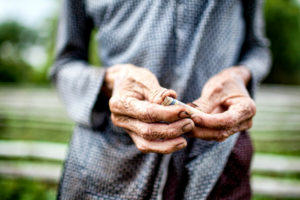
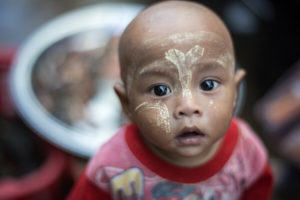
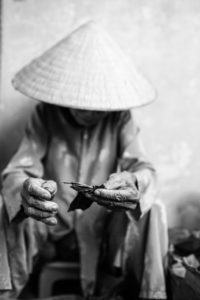
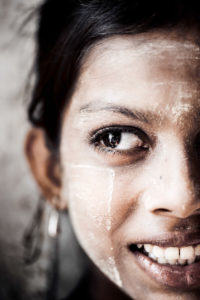
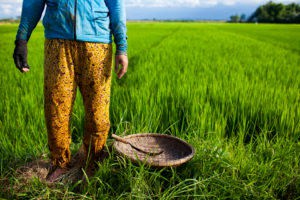
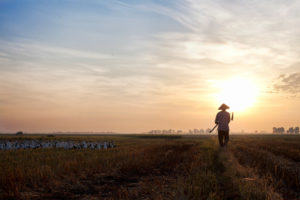
Both views are valid for me i use both wide and telephoto lens and a 50 mm great debate!!! Much respect for both of you!!!
[…] A while ago, I met Tad during a photo tour in Hoi An. Following this tour we have had an email discussion about 2 different ways of shooting people while traveling: getting close or staying far from your subject? […]
I can see both sides of the coin and I think that both views have their place. Best to keep an open mind and assess the situation that arises and make your choice then. It is an interesting discussion thank you Etienne and Tad for your comments.
Is it alright if I tweet about this blog?
Please Brett share the passion for photography! 🙂